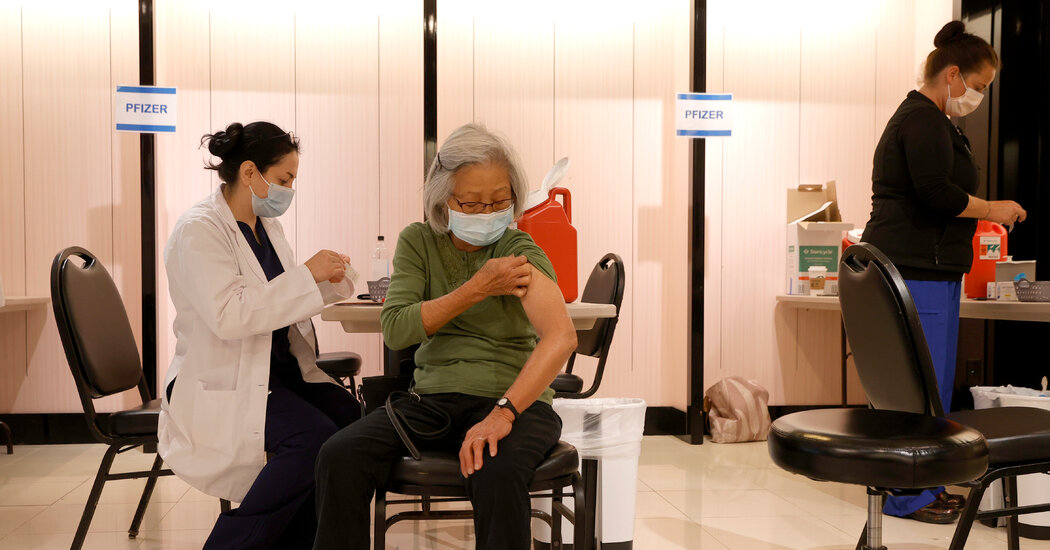
WASHINGTON — Johnson & Johnson is planning to ask federal regulators early this week to authorize a booster shot of its coronavirus vaccine, according to officials familiar with the company’s plans. The firm is the last of the three federally authorized vaccine providers to call for extra injections, amid mounting evidence that at least the elderly and other high-risk groups need more protection.
Federal officials have become increasingly worried that the more than 15 million Americans who received the Johnson & Johnson vaccine face too much risk of severe Covid-19. The Food and Drug Administration on Friday scheduled a meeting on Oct. 15 of its expert advisory committee to discuss whether to grant emergency use authorization of a booster shot of Johnson & Johnson’s vaccine.
That is part of a broader effort by the government to shore up the protection provided by all three vaccines. Regulators last month authorized a booster shot for many recipients of Pfizer-BioNTech’s vaccine and are contemplating doing the same this month for recipients of Moderna’s.
The fact that the advisory committee meeting on Johnson & Johnson was scheduled even before the company filed an application to the Food and Drug Administration reflects a particular sense of urgency in the Biden administration to provide more protection to recipients of that vaccine.
Although the federal government has emphasized for months that all three vaccines are highly effective, a recent study by the Centers for Disease Control and Prevention found that Johnson & Johnson’s single-dose vaccine was only 71 percent effective against hospitalization from Covid-19, compared with 88 percent for Pfizer-BioNTech’s vaccine and 93 percent for Moderna’s.
“Real-world data suggest that the two-dose Moderna and Pfizer-BioNTech mRNA vaccine regimens provide more protection” than the single dose of Johnson & Johnson, the researchers said. Other research found that Johnson & Johnson recipients were more likely to have breakthrough infections or symptomatic Covid-19 than recipients of the other two vaccines.
Johnson & Johnson cites some studies with better results: A study of nearly two million people, funded by the company, estimated that the vaccine was 81 percent effective against hospitalization. Other research suggests that protection from Johnson & Johnson’s vaccine does not wane over time like protection from Pfizer-BioNTech’s vaccine.
Nonetheless, Johnson & Johnson now appears to agree with federal officials that a single shot of its vaccine is not enough.
Last month, the company announced that a second dose, given two months after the first, increased the vaccine’s effectiveness against symptomatic Covid-19 by about 22 percentage points, to 94 percent. The firm also said two shots were 100 percent effective against severe disease, although that estimate was less conclusive.
“The data shows that there is a dramatic increase in efficacy when the boost is given at two months. And we believe that it’s potentially even better when given later,” said Dr. Dan H. Barouch, a virologist at Beth Israel Deaconess Medical Center in Boston who helped develop the vaccine.
“I’m not a public health authority, but I would say it’s scientifically reasonable for people who are desiring a higher level of efficacy to obtain a booster shot” between two to six months after the first shot of the vaccine, he said.
At a meeting of a C.D.C. advisory committee in September, some independent experts questioned whether Johnson & Johnson recipients were being forgotten while the federal government moved to authorize a third shot for Pfizer recipients.
“To me, the biggest policy question out there is the Johnson & Johnson,” Dr. Helen Keipp Talbot, an internist and infectious disease specialist at Vanderbilt University, said at the meeting last month, where the committee weighed whether to recommend a third shot for some Pfizer recipients. “I worry we’re getting distracted by the question of boosters of Pfizer when we have bigger and more important things to do in the pandemic.”
Dr. Nirav D. Shah, Maine’s top health official and the president of the Association of State and Territorial Health Officials, said that after the Johnson & Johnson vaccine became available this spring, many states directed it to rural areas because it required only one injection and was easier to transport.
“It is rural areas that are getting particularly hit right now” by the Delta variant, Dr. Shah said. “So I think there is good reason to offer J. & J. recipients a booster if the data support it.”
In San Francisco last month, health officials said Johnson & Johnson recipients would be permitted to receive a booster shot of either the Moderna or Pfizer vaccine. “If people talk to their health care provider and say, ‘I’d really like to have an mRNA shot in addition to the Johnson & Johnson shot that I got,’ we will accommodate that,” Dr. Grant Colfax, the city’s public health director, told reporters.
For federal regulators and the government’s panels of outside experts, key questions remain: How long after an initial Johnson & Johnson injection should a second shot be administered? And would it be better to boost Johnson & Johnson recipients with a shot of Moderna’s or Pfizer’s vaccine?
If the Food and Drug Administration authorizes a second shot six months after the initial injection, that would allow the company to market its vaccine as a one-shot regimen, plus a booster. Some data indicate a second shot at six months produced a stronger immune response than a second shot at two months.
Researchers found a nine- to twelvefold increase in antibodies among clinical trial recipients who received a second shot after six months, compared with a roughly fourfold increase for people who received a second dose after two months, Dr. Barouch said.
But there could be a trade-off: Some argue that Johnson & Johnson recipients would not be sufficiently protected during the extra months before a second shot, and that a two-dose regimen made more sense from the start.
The timing is not a trivial question: According to C.D.C. data, more than two-thirds of Johnson & Johnson recipients were vaccinated at least four months ago. Many would not be immediately eligible if a booster shot was available only six months after the first injection.
The State of Vaccine Mandates in the U.S.
-
- Vaccine rules. On Aug. 23, the F.D.A. granted full approval to Pfizer-BioNTech’s coronavirus vaccine for people 16 and up, paving the way for mandates in both the public and private sectors. Such mandates are legally allowed and have been upheld in court challenges.
- College and universities. More than 400 colleges and universities are requiring students to be vaccinated against Covid-19. Almost all are in states that voted for President Biden.
- Schools. California became the first state to issue a vaccine mandate for all educators and to announce plans to add the Covid-19 vaccine as a requirement to attend school, which could start as early as next fall. Los Angeles already has a vaccine mandate for public school students 12 and older that begins Nov. 21. New York City’s mandate for teachers and staff, which went into effect Oct. 4 after delays due to legal challenges, appears to have prompted thousands of last-minute shots.
- Hospitals and medical centers. Many hospitals and major health systems are requiring employees to get vaccinated. Mandates for health care workers in California and New York State appear to have compelled thousands of holdouts to receive shots.
- New York City. Proof of vaccination is required of workers and customers for indoor dining, gyms, performances and other indoor situations. City education staff and hospital workers must also get a vaccine.
- At the federal level. On Sept. 9, President Biden announced a vaccine mandate for the vast majority of federal workers. This mandate will apply to employees of the executive branch, including the White House and all federal agencies and members of the armed services.
- In the private sector. Mr. Biden has mandated that all companies with more than 100 workers require vaccination or weekly testing, helping propel new corporate vaccination policies. Some companies, like United Airlines and Tyson Foods, had mandates in place before Mr. Biden’s announcement.
The prospect of using a different vaccine as a booster presents another dilemma. A study by the National Institutes of Health suggests that Moderna’s vaccine works better as a booster than a second shot of Johnson & Johnson. But Dr. Barouch said that study only measured antibody levels — an indication of the strength of the immune system’s response — while Johnson & Johnson’s study of a second shot of its own vaccine looked at efficacy data.
Johnson & Johnson is also considered likely to fight for using its own vaccine as a second shot to protect its public image. The company struggled for months with manufacturing problems that delayed delivery of tens of millions of doses it had promised to the federal government. And the vaccine’s appeal dropped after it was linked to a rare but serious blood-clotting disorder and injections were paused for 10 days in April. It remains a distant third in the number of shots administered in the United States.
People eligible for Pfizer’s booster include those 65 and older and those who live in long-term care facilities, have underlying medical conditions or are at higher risk of exposure to the virus because of their jobs or institutional settings, a group that includes health care workers, teachers and prisoners.
The Food and Drug Administration and the C.D.C. are expected to propose essentially the same criteria for booster shots of Moderna and Johnson & Johnson, although there is some discussion about whether to broaden eligibility to include more middle-aged people, according to people familiar with the situation.
Moderna’s request for authorization of a booster shot is up next, with a meeting scheduled for Oct. 14, the day before the Johnson & Johnson discussion. Some experts suggest that the company’s supporting data is even more scant than Pfizer’s.
Multiple studies indicate that the potency of Moderna’s vaccine wanes less over time than Pfizer’s. Moderna officials suggest that is because the dosage is stronger and the interval between shots is a week longer than in Pfizer’s regimen.
On the other hand, the fact that the government has set a precedent in authorizing a Pfizer booster could generate momentum for extra shots of the other two vaccines. Otherwise, health care officials are left trying to explain why only Pfizer recipients are eligible for boosters.
In Maine, for example, Dr. Shah said that health care staff who are administering booster injections are telling nursing home residents: “We’re really sorry, right now it’s only for those who got Pfizer, but don’t worry. Just because you’re not getting a booster today, does not mean your protection level has fallen to zero. We’ll be back, if and when” boosters of the other vaccines are cleared.
“That’s a tough conversation to have,” he said.
More support might come from Israeli health officials, who presented data last month at the Food and Drug Administration’s advisory committee hearing on a Pfizer booster. Israel has relied almost entirely on Pfizer’s vaccine.
According to summaries of the country’s latest data, extra shots of Pfizer’s vaccine are associated with significantly lower rates of infection, severe Covid-19 and, among those 60 or older, death.
At this point, federal officials and some of the government’s outside experts have accepted that they are making decisions with data that is less than perfect. As with the other vaccines, the data on Johnson & Johnson’s efficacy is fragmented and to some extent contradictory, discrepancies that may be at least partly explainable by whether the highly contagious Delta variant was dominant among the population being studied.
“The data are somewhat all over the place,” Dr. Shah said. “That is the nature of science.”
Noah Weiland contributed reporting.







